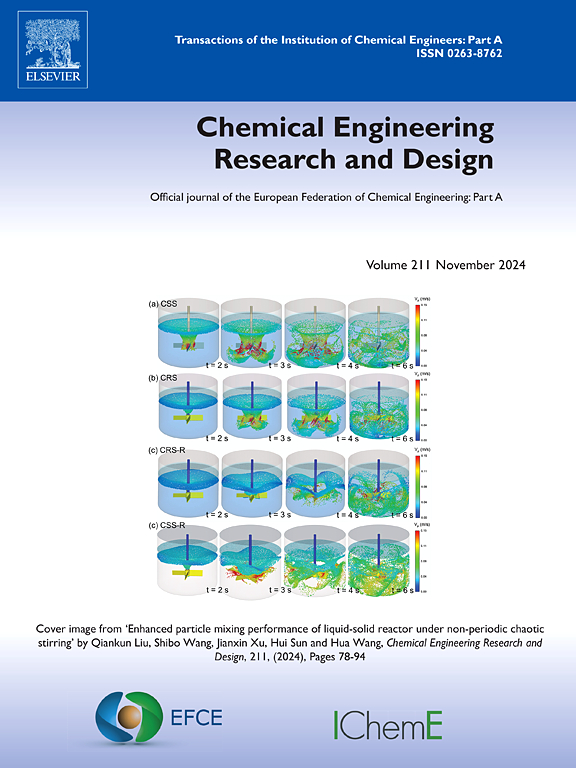废润滑油资源再生利用的结焦机理及治理策略
IF 3.7
3区 工程技术
Q2 ENGINEERING, CHEMICAL
引用次数: 0
摘要
在生物质利用、石油炼制过程和其他相关领域,焦化对设备结垢、催化剂失活和管道堵塞有重大影响。因此,焦化是这些领域研究的重要方面之一,其产生的机理与焦化现象本身一样复杂。复杂性本质上是耦合机制,只有充分认识这种复杂性,才能更好地指导可再生资源的利用。在本研究中,首次研究了在低于400 °C的温度下废润滑油脱金属预处理的气液相焦炭结构的演变。进一步分析了废润滑油热解预处理气相焦化的主要影响因素及机理。最后,提出了一种防止结焦的方法并进行了验证。结果表明,金属催化剂促进液相焦炭的形成,形成的焦炭以丝状为主。焦炭形成初期的气相反应主要是由盐酸催化废润滑油热裂解烯烃的Diels-Alder型反应引起的。由Diels-Alder反应生成的多环化合物在薄片上的平面膨胀伴随着部分脱氢,最后通过这些平面之间的垂直连接形成三维颗粒。从简单的芳烃开始,发生脱氢和缩合反应,产生烟灰颗粒或焦油滴,在热裂解反应器中可以是液体甚至固体。由于液滴的外表面没有完全脱氢,它们粘附在表面并被纳入焦炭层。其次,脱氢反应是可能的,焦炭层可以进一步生长。同时,焦炭中含有Cl, Cl进一步催化裂化,形成自催化焦炭。另一方面,高沸点产物在气相沉积板上的冷凝和最终脱氢生成焦炭是次要原因。在此基础上,建立了年产100 t/年的中试装置,实现了624 h的连续稳定运行。并通过加氢工艺对预处理工艺进行了验证。对生物质气相焦化、生物油热解和其他物质热解气相焦化也具有重要的理论指导意义。重要的是,我们的研究结果提供了可靠和有效的关于ULO再生预处理的模型,对未来ULO加氢精制和资源利用有帮助。本文章由计算机程序翻译,如有差异,请以英文原文为准。
Coking mechanism and abatement strategy of used lubricating oil resource regenerative utilization
Coking has a major impact on equipment fouling, catalyst deactivation and pipe clogging, in biomass utilization, petroleum refinery processes and other related fields. Therefore, coking is one of important aspects of research in these fields and generates mechanism as intricate as the phenomenon itself. Complexity is essentially coupled to the mechanisms and promote the utilization of renewable resources can be better guided if fully understanding this complexity. In this study, the evolution of gas-liquid phase coke structures of used lubricating oil demetallization pretreatment at temperatures below 400 °C was first investigated. Then, the main influencing factors and mechanism of used lubricating oil pyrolysis pretreatment gas-phase coking are further presented. Finally, a method for preventing coking is proposed and verified. Our results show that metal catalysts promote the formation of liquid-phase coke, where the coke formed was mainly filamentous. And gas-phase reactions at the early stage of coke formation were mainly attributed to HCl-catalyzed Diels-Alder type reaction of olefins produced by used lubricating oil thermal cracking. The planar expansion of the polycyclic compound generated by the Diels–Alder reaction in the sheet was accompanied by partial dehydrogenation, and finally, three-dimensional particles are formed by the vertical connection between these planes. Starting with simple aromatics, dehydrogenation and condensation reactions occurred to produce soot particles or tar droplets that could be liquid or even solid in a thermal cracking reactor. They adhered to the surface and were incorporated in the coke layer because the outer surface of the droplets was not completely dehydrogenated. Next, dehydrogenation reactions were possible, and the coke layer could grow further. Meanwhile, coke contains Cl, which further catalyzed the cracking leading to the formation of autocatalytic coke. On the other hand, the condensation of high boiling products on the gas deposition sheet and eventual dehydrogenation to form coke were the secondary causes. Based on this research, we established a pilot plant with an annual output of 100 t/ year, which has achieved continuous and stable operation for 624 h. And the pretreatment process has been verified by the hydrogenation process. It also has great theoretical guiding significance for gas-phase coking of biomass, bio-oil pyrolysis and pyrolysis gas-phase coking of other substances. Significantly, our results provide reliable and effective models relating to ULO regenerative pretreatment, which should be helpful in future ULO hydrorefining and resource utilization.
求助全文
通过发布文献求助,成功后即可免费获取论文全文。
去求助
来源期刊

Chemical Engineering Research & Design
工程技术-工程:化工
CiteScore
6.10
自引率
7.70%
发文量
623
审稿时长
42 days
期刊介绍:
ChERD aims to be the principal international journal for publication of high quality, original papers in chemical engineering.
Papers showing how research results can be used in chemical engineering design, and accounts of experimental or theoretical research work bringing new perspectives to established principles, highlighting unsolved problems or indicating directions for future research, are particularly welcome. Contributions that deal with new developments in plant or processes and that can be given quantitative expression are encouraged. The journal is especially interested in papers that extend the boundaries of traditional chemical engineering.
 求助内容:
求助内容: 应助结果提醒方式:
应助结果提醒方式:


